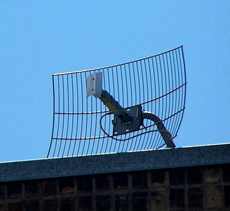Microwaves
In amateur radio the part of the electromagnetic spectrum above a frequency of 1 GHz is referred to as the microwave and millimetre-wave region and includes a number of amateur radio microwave bands
Introduction
These bands present the radio amateur with the chance for innovation, experimentation and the satisfaction of real achievement. This may include the design and construction of microwave hardware, the study of propagation effects, and the use of new modulation techniques such as digital modes or making long distance contacts. See below and these subpages for more!
Radio amateurs operating on the microwave bands have access to relatively large segments of the radio spectrum compared to the HF and VHF bands. This allows the use of all modulation modes used on lower frequencies as well as relatively wide band modes such as Amateur Television (ATV) and high speed data links.
Amateur stations
 Access to equipment intended for the First Person Video (FPV) (e.g. drone) market makes for relatively simple and inexpensive systems that can provide surprisingly good results, especially whilst operating from hill top sites.
Access to equipment intended for the First Person Video (FPV) (e.g. drone) market makes for relatively simple and inexpensive systems that can provide surprisingly good results, especially whilst operating from hill top sites.
There are also a large number of fixed stations that have put together equipment capable of long distance contacts particularly on the lower microwave bands, often taking advantage of propagation modes not available at lower frequencies. These are modes including tropospheric, rain and aircraft scatter as well as tropospheric ducting. Distances of several hundred km are usually possible extending out to 1000km or more with enhanced conditions. Even worldwide contacts are possible by bouncing microwave signals off the moon. In addition some amateur radio satellites carry microwave transponders allowing voice, data and even digital television signals to be re-broadcast to large areas of the world.
Operating
 Microwave operating differs from HF operating in that most contacts are by pre-arranged skeds or by using talkback; which nowadays is likely to be via an internet chat client, the most commonly used being ON4KST chat, or by using the microwave calling frequency 144.390MHz. The exception to this is likely to be during contests or activity periods. The main reason why it is not usually very profitable to call CQ is because of the narrow beam widths of microwave antennas. With narrow beam width antennas it is important to be able to align antennas accurately for successful contacts. A number of web based programs enable headings to be computed by inputting locator data.
Microwave operating differs from HF operating in that most contacts are by pre-arranged skeds or by using talkback; which nowadays is likely to be via an internet chat client, the most commonly used being ON4KST chat, or by using the microwave calling frequency 144.390MHz. The exception to this is likely to be during contests or activity periods. The main reason why it is not usually very profitable to call CQ is because of the narrow beam widths of microwave antennas. With narrow beam width antennas it is important to be able to align antennas accurately for successful contacts. A number of web based programs enable headings to be computed by inputting locator data.
Both the RSGB and the UK Microwave Group (UKuG) organise contests throughout the year. The Tuesday evening UKAC series organised by the RSGB is particularly popular with good levels of activity and cover 1.3GHz to 10GHz. The UKuG contests and activity periods held on a Sunday are particularly suited to portable operation, they cover 1.3GHz up to 241GHz at various times of the year. Many of the contests are coordinated with other countries in Europe thus allowing the potential for DX contacts.
There are also contests and activity periods organized by the British Amateur Television Club (BATC) and by the EME community.
The Monday evening microwave activity across the south and southwest of England regularly sees contacts on bands from 1.3GHz to 24GHz. Wednesday evening is the time when experimentation using digital techniques takes place around the UK.
During enhanced conditions contacts over many hundred km are possible even from home stations on bands up to 10 or 24GHz.
Microwave beacons
![]()
Microwave operation and equipment testing is supported by an extensive network of propagation beacons that are sited on high spots to ensure maximum coverage. They are operated by local groups and often there are rental charges for use of the site as well as the cost of electricity, so groups need financial support. The UK Microwave Group (UKuG) does make funds available for the initial purchase of equipment.
Beacons act as both propagation indicators and a check on receiver performance. Because most beacons are frequency locked to a frequency standard they are also useful as a calibration aid for transverter alignment. Beacons currently operate in all bands between 1.3GHz and 47GHz. They always transmit a CW identification (call sign) and many transmit beacon information in a digital format. A very useful resource available to the microwave amateur is the web-based www.beaconspot.uk, which lists all active beacons together with their status and operating parameters. Amateurs are able to upload ‘Spots’ to indicate where beacons have been heard and enable others to monitor propagation over a wide area.
There are a surprising number of propagation indicator beacons covering much of the UK, operating on all microwave bands from 1.3GHz to 134GHz. Most UK beacons are now frequency locked to GPS derived frequency standards, so their frequency can be relied-on to a few tens of Hz.











